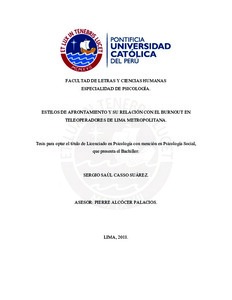| dc.contributor.advisor | Alcócer Palacios, Pierre | |
| dc.contributor.author | Casso Suárez, Sergio Saúl | es_ES |
| dc.date.accessioned | 2018-12-06T17:09:43Z | es_ES |
| dc.date.available | 2018-12-06T17:09:43Z | es_ES |
| dc.date.created | 2018 | es_ES |
| dc.date.issued | 2018-12-06 | es_ES |
| dc.identifier.uri | http://hdl.handle.net/20.500.12404/13093 | |
| dc.description.abstract | El presente estudio está enmarcado en la teoría del síndrome de burnout en entornos
organizacionales y tiene como objetivo identificar la intensidad y dirección de la
correlación entre el índice de burnout y los estilos de afrontamiento que suele presentar una
muestra de teleoperadores de una empresa de Call Center (n=100) de Lima Metropolitana.
Para esto, se buscó explorar los diferentes estilos de afrontamiento que suele utilizar esta
muestra desde una aproximación émica y medir el nivel de burnout de los participantes. El
estudio reveló que en dicha muestra no se registra la presencia del síndrome de burnout; los
estilos de afrontamiento de la muestra suelen ser de practicar ejercicios físicos, ejercicios
relajantes y visitar a la familia, ver películas acompañado y recibir masajes y salir a
caminar o a bailar con alguien. Además de ello, se halló una correlación positiva entre un
factor de burnout (agotamiento emocional) y un factor de afrontamiento (practicar
ejercicios físicos, ejercicios relajantes y visitar a la familia). En base a esto, se puede decir
que la práctica regular de un ejercicio moderado, que no resulte agotador, y el resguardo
familiar, previene y combate el agotamiento emocional causado por el burnout. | es_ES |
| dc.description.abstract | This study is based on the theory of the burnout syndrome in organizational settings and it
aims to identify the strength and direction of the correlation between the level of burnout
and coping styles that a sample of teleoperators from a call center company located in Lima
(n = 100) usually performs. For this, it sought to explore the different coping stalyes this
sample uses as from an emic approach and also measure the level of burnout of the
participants. The study showed that in this sample there are not presence of burnout
syndrome registered; coping styles mainly are associated to practice physicial exercises,
relaxing exercises and visit the family, watch movies accompanied and receive massages
and go for a walk or dance with someone. Furthermore, a positive correlation between a
factor of burnout (emotional distress) and a factor of coping (practice physical exercises,
relaxing exercises and visit the family) was found. Based on this, it can be said that the
regular practice of a moderate exercise, which is not exhausting, and the family safeguard
prevents and combats the emotional distress caused by burnout. | es_ES |
| dc.language.iso | spa | es_ES |
| dc.publisher | Pontificia Universidad Católica del Perú | es_ES |
| dc.rights | info:eu-repo/semantics/openAccess | es_ES |
| dc.rights.uri | http://creativecommons.org/licenses/by/2.5/pe/ | * |
| dc.subject | Stress en el trabajo | es_ES |
| dc.subject | Trabajo--Aspectos psicológicos | es_ES |
| dc.subject | Adaptación (Psicología) | es_ES |
| dc.title | Estilos de afrontamiento y su relación con el Burnout en teleoperadores de Lima Metropolitana | es_ES |
| dc.type | info:eu-repo/semantics/bachelorThesis | es_ES |
| thesis.degree.name | Licenciado en Psicología Social | es_ES |
| thesis.degree.level | Título Profesional | es_ES |
| thesis.degree.grantor | Pontificia Universidad Católica del Perú. Facultad de Letras y Ciencias Humanas | es_ES |
| thesis.degree.discipline | Psicología Social | es_ES |
| renati.advisor.dni | 42292220 | |
| renati.advisor.orcid | https://orcid.org/0000-0001-5325-001X | es_ES |
| renati.discipline | 313066 | es_ES |
| renati.level | https://purl.org/pe-repo/renati/level#tituloProfesional | es_ES |
| renati.type | http://purl.org/pe-repo/renati/type#tesis | es_ES |
| dc.publisher.country | PE | es_ES |
| dc.subject.ocde | http://purl.org/pe-repo/ocde/ford#5.01.00 | es_ES |






